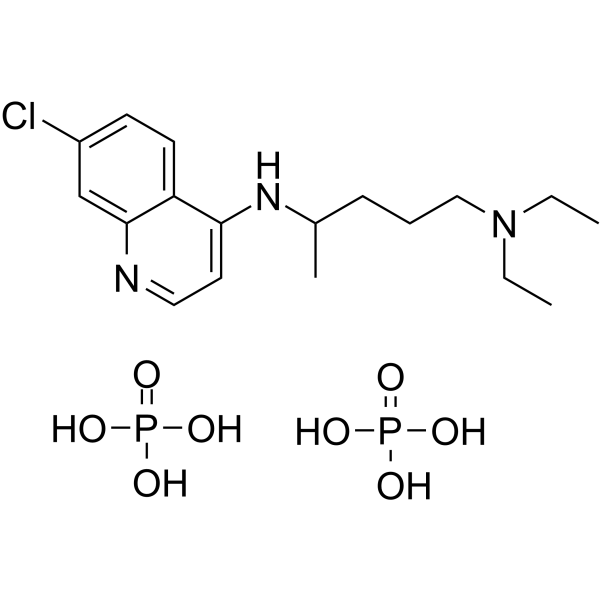Chloroquine phosphate (Synonyms: 磷酸氯喹) 纯度: 99.85%
Chloroquine phosphate 是一种广泛用于疟疾和类风湿性关节炎的抗疟疾和抗炎剂。Chloroquine phosphate 是 autophagy 和 toll-like receptors (TLRs) 的抑制剂。Chloroquine phosphate 有效抑制 SARS-CoV-2 (COVID-19) 感染 (EC50=1.13 μM)。

Chloroquine phosphate Chemical Structure
CAS No. : 50-63-5
| 规格 | 价格 | 是否有货 | 数量 |
|---|---|---|---|
| Free Sample (0.1-0.5 mg) | Apply now | ||
| 10 mM * 1 mL in Water | ¥550 | In-stock | |
| 100 mg | ¥500 | In-stock | |
| 200 mg | ¥875 | In-stock | |
| 500 mg | ¥1750 | In-stock | |
| 1 g | 询价 | ||
| 5 g | 询价 |
* Please select Quantity before adding items.
Chloroquine phosphate 相关产品
•相关化合物库:
- Drug Repurposing Compound Library Plus
- FDA-Approved Drug Library Plus
- FDA-Approved Drug Library Mini
- Bioactive Compound Library Plus
- Anti-Infection Compound Library
- Immunology/Inflammation Compound Library
- FDA-Approved Drug Library
- Anti-Cancer Compound Library
- Antiviral Compound Library
- Autophagy Compound Library
- Small Molecule Immuno-Oncology Compound Library
- Drug Repurposing Compound Library
- Antioxidants Compound Library
- Differentiation Inducing Compound Library
- Oxygen Sensing Compound Library
- Anti-COVID-19 Compound Library
- NMPA-Approved Drug Library
- Pyroptosis Compound Library
- FDA Approved & Pharmacopeial Drug Library
- Antibiotics Library
- Drug-Induced Liver Injury (DILI) Compound Library
- Antiparasitic Compound library
- Targeted Diversity Library
- Rare Diseases Drug Library
- Children’s Drug Library
| 生物活性 |
Chloroquine phosphate is an antimalarial and anti-inflammatory agent widely used to treat malaria and rheumatoid arthritis. Chloroquine phosphate is an autophagy and toll-like receptors (TLRs) inhibitor. Chloroquine phosphate is highly effective in the control of SARS-CoV-2 (COVID-19) infection in vitro (EC50=1.13 μM)[1][2][3][4]. |
||||||||||||||||
|---|---|---|---|---|---|---|---|---|---|---|---|---|---|---|---|---|---|
| IC50 & Target[1][2][3][5] |
|
||||||||||||||||
| 体外研究 (In Vitro) |
Chloroquine (CHQ, 20 μM) inhibits IL-12p70 release and reduces Th1-priming capacity of activated human monocyte-derived Langerhans-like cells (MoLC). Chloroquine (CHQ, 20 μM) enhances IL-1–induced IL-23 secretion in MoLC and subsequently increases IL-17A release by primed CD4+ T cells[1]. Chloroquine (25 μM) suppresses MMP-9 mRNA expression in normoxia and hypoxia in parental MDA-MB-231 cells. Chloroquine has cell-, dose- and hypoxia-dependent effects on MMP-2, MMP-9 and MMP-13 mRNA expression[2]. TLR7 and TLR9 inhibition using IRS-954 or chloroquine significantly reduces HuH7 cell proliferation in vitro[3]. MCE has not independently confirmed the accuracy of these methods. They are for reference only. |
||||||||||||||||
| 体内研究 (In Vivo) |
Chloroquine (80 mg/kg, i.p.) does not prevent the growth of the triple-negative MDA-MB-231 cells with high or low TLR9 expression levels in the orthotopic mouse model[2]. TLR7 and TLR9 inhibition using IRS-954 or chloroquine significantly inhibits tumour growth in the mouse xenograft model. HCC development in the DEN/NMOR rat model is also significantly inhibited by chloroquine[3]. MCE has not independently confirmed the accuracy of these methods. They are for reference only. |
||||||||||||||||
| Clinical Trial |
|
||||||||||||||||
| 分子量 |
515.86 |
||||||||||||||||
| Formula |
C18H32ClN3O8P2 |
||||||||||||||||
| CAS 号 |
50-63-5 |
||||||||||||||||
| 中文名称 |
磷酸氯喹;氯喹宁二磷酸盐;氯化喹啉磷酸盐;氯喹磷酸盐;磷酸氯化喹啉;磷酸氯喹啉;二磷酸氯喹;氯喹二磷酸盐 |
||||||||||||||||
| 运输条件 |
Room temperature in continental US; may vary elsewhere. |
||||||||||||||||
| 储存方式 |
4°C, sealed storage, away from moisture and light *In solvent : -80°C, 6 months; -20°C, 1 month (sealed storage, away from moisture and light) |
||||||||||||||||
| 溶解性数据 |
In Vitro:
H2O : ≥ 33 mg/mL (63.97 mM) DMSO : < 1 mg/mL (ultrasonic) (insoluble or slightly soluble) * “≥” means soluble, but saturation unknown. 配制储备液
*
请根据产品在不同溶剂中的溶解度选择合适的溶剂配制储备液;一旦配成溶液,请分装保存,避免反复冻融造成的产品失效。 |
||||||||||||||||
| 参考文献 |
|
| Cell Assay [2] |
The cells are cultured in 6-well plates with normal culture medium in the presence of vehicle or 25 or 50 μM chloroquine, until near confluency, after which they are rinsed with sterile phosphate-buffered saline (PBS) and cultured further for the indicated times in serum-free culture medium. At the desired time-points, the culture medium is discarded and the cells are quickly harvested in lysis buffer and clarified by centrifugation. Subsequent to boiling the supernatants in reducing sodium dodecyl sulphate (SDS) sample buffer, equal amounts of protein (100 μg) are loaded per lane and the samples are electrophoresed into 10 or 4-20% gradient polyacrylamide SDS gels, then transferred to a nitrocellulose membrane. To detect TLR9, the blots are incubated overnight at 4°C with anti-TLR9 antibodies, diluted 1:500 in Tris-buffered saline with 0.1% (v/v) Tween-20 (TBST). Equal loading is confirmed with polyclonal rabbit anti-actin. Secondary detection is performed with horseradish peroxidase-linked secondary antibodies. The protein bands are visualized by chemiluminescence using an ECL kit. MCE has not independently confirmed the accuracy of these methods. They are for reference only. |
|---|---|
| Animal Administration [2] |
Control and TLR9 siRNA MDA-MB-231 cells (5×105 cells in 100 μL) are inoculated into the mammary fat pads of four-week-old, immune-deficient mice (athymic nude/nu Foxn1). Treatments are started seven days after tumor cell inoculation. The mice are treated daily either with intraperitoneal (i.p.) chloroquine (80 mg/kg) or vehicle (PBS). The animals are monitored daily for clinical signs. Tumor measurements are performed twice a week and tumor volume is calculated according to the formula V=(π/6) (d1×d2)3/2, where d1 and d2 are perpendicular tumor diameters. The tumors are allowed to grow for 22 days, at which point the mice are sacrificed and the tumors are dissected for a final measurement. Throughout the experiments, the animals are maintained under controlled pathogen-free environmental conditions (20-21°C, 30-60% relative humidity and a 12-h lighting cycle). The mice are fed with small-animal food pellets and supplied with sterile water ad libitum. MCE has not independently confirmed the accuracy of these methods. They are for reference only. |
| 参考文献 |
|
